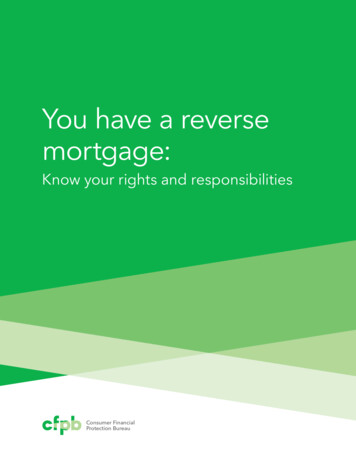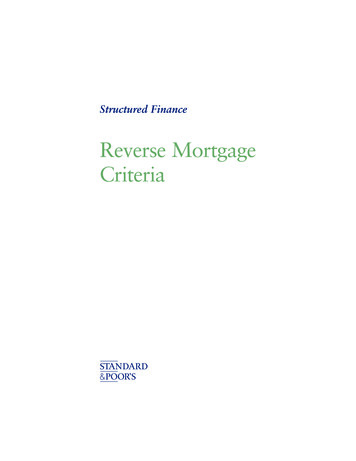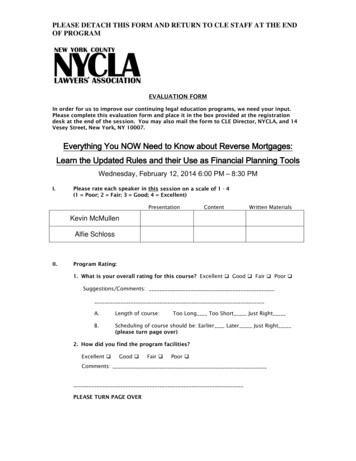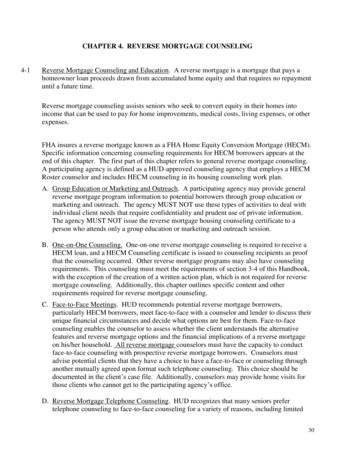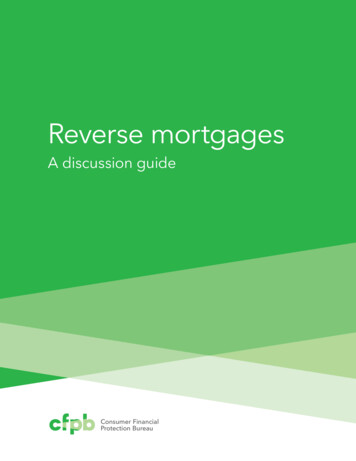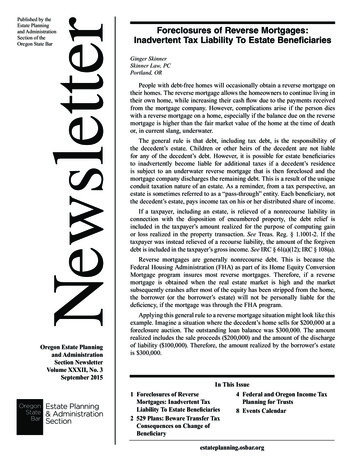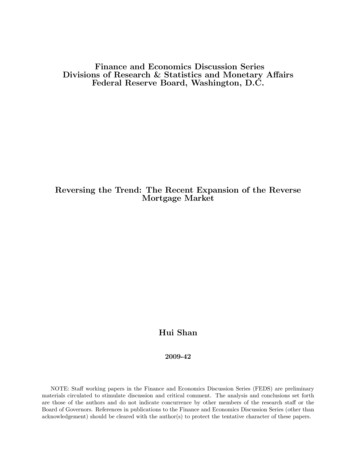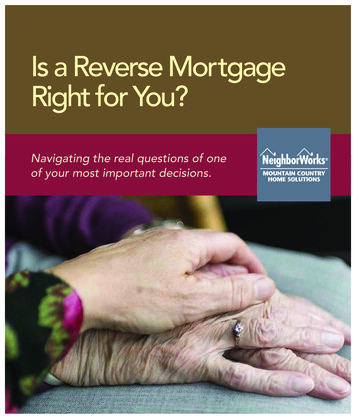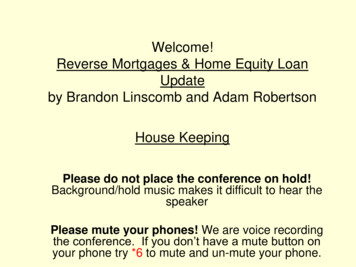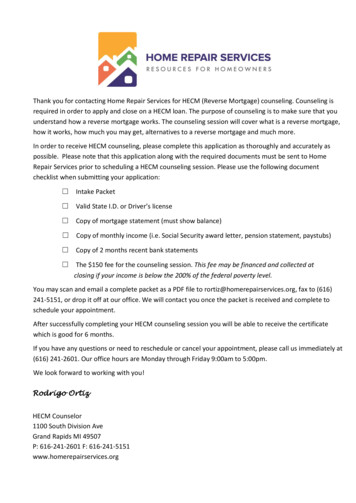
Transcription
REVERSEMORTGAGEWhy Your Home Asset Powers a More Secure RetirementProtect Your KingdomPYK 1121 115Don Graves 1-800-762-6315
Table of ContentsDon Graves 1-800-762-6315
The 15 Risks at a Glance04Consider a Home EquityConversion Mortgage06The New Home Equity ConversionMortgage. Do You Knowthe Facts?085 Ways to Generate GreaterSecurity in Retirement10Eliminate Mandatory Principaland Interest Payments12Mitigate Early Adverse Sequenceof Returns with a HECM13Purchase a New Retirement HomeWithout Mandatory Mortgage Paymentsor Portfolio Invasion14The HECM for Purchase Program 15What’s the Cost of Delaying?19What is the Price of Setting Up a HECMand What Does it Buy?23Don Graves 1-800-762-6315
15 RISKS THATCOULD IMPACT YOURRETIREMENTDo Any of These Describe You?If so, you might benefit from an HECM Social security and pension payments barely cover the bills Worried that you may outlive your money Still have a mortgage payment in retirement Concerned that social security and/or Medicare may not be there in the future4Don Graves 1-800-762-6315
15 Risks That Could Impact Your RetirementLongevity Risk — The risk of outliving assetsInflation Risk — Necessities become too expensiveBudget Risk — Spending too much of your nest egg early in retirementHealth Related Risk — Escalating unanticipated health, drug, dental and hearing costsLong Term Care Risk — Coverage and policy lapses in LTCI planning to self-insureFrailty Risk — Tasks such as attending to financial affairs or taking care of propertybecome more difficultFinancial Elder Abuse Risk — Fraud occurring because of cognitive/physical declineMarket Risk — Nest egg values swing up and down; inflation erodes buying powerInterest Rate Risk — Cost of borrowing is higher and savings do not earn as muchLiquidity Risk — Excess ratio of wealth concentrated in illiquid, indivisible asset such asreal estateAdverse Sequence Of Return Risk —Spending from savings in a down market early inretirement has long term negative effectsLabor Risk — Retiring early and/or being unable to return to the workforcePension Risk — Insolvent/reduced pension fundsSpousal Loss Risk — The loss of income from one’s spousePublic Policy Risk — Regulatory and legislative changes to Social Security, Medicare that couldaffect retirement securityConsider these risks, what if you could: Enjoy greater peace of mind with an asset youalready own Have access to your home asset throughoutretirement without sacrificing security and comfort Benefit from a revolving line of credit that cannotbe frozen or reduced and will continue to growregardless of your home’s value* Applies only to HECM Line of Credits** Provided borrower occupies home as their primary residence, pays property taxes, homeowners insurance and maintains the property.5
Consider a Home Equity Conversion Mortgage(HECM)A mortgage with special features to meet retirement needsMonthly principal and interest payments completely voluntaryInsured by FHA as a non-recourse loan to homeowner and the estateTHE TRUTHABOUT HECMSWhen it comes to HECMs, there are manymisconceptions. It pays to know the truth.6Don Graves 1-800-762-6315
Credit Determinants Age of youngest borrower Value of home Current interest rate Occupancy as principal residenceJust Like Any Other Mortgage You Must:Four CommonMisconceptions About HECMs1. The Bank Takes Backthe HouseYou retain title and the bank does not getthe house unless a default event occurs. Maintain tax and insurance obligations Stay current on HOA fees Maintain your home in reasonable repair Demonstrate willingness and capacity at applicationto meet your homeowner responsibilitiesHow You Can Take the Money Lump sum for divorce settlement, home purchaseor pay off of existing mortgage Tenure payments for duration of time in the hometo supplement retirement income Term payments to meet specific needs for a definedtime period Revolving line of credit with compoundinggrowth feature Combination of the above optionsYour Repayment Options2. You Are Leaving a Debt forYour Heirs to Pay & You MayHave to MoveWhen the loan becomes due, you do notowe more than the home’s value. Anyremaining equity beyond the loan balancebelongs to the estate. Your heirs mayretain the home by paying the lesser ofthe loan balance or 95% of the appraisedvalue of the home.3. You May Have to MoveSome mistakenly believe once the moneyis used up, the loan is due. Actually, theloan is in effect as long as one of you usesthe home as a primary residence andmaintains homeowner responsibilitiessuch as taxes and insurance. Repayment is deferred until you die, move or sell Monthly mortgage payments are accepted at yourdiscretion, but never required With an adjustable-rate HECM, your payments tothe loan will reduce the amount owed on the line ofcredit, allowing it to be accessed multiple times aslong as the loan balance does not exceed the creditavailability.Don Graves 1-800-762-63154. Once You Have a ReverseMortgage You Are StuckYou are not required to make a paymenton the principal or interest until thelast participant dies, moves or sells theproperty (provided obligations are metand property tax and insurance paymentsare current). However, you may makepayments of your choosing if you desire tocontrol the loan balance; at any time youwish to pay off the reverse mortgage thereare no penalties.*The loan is in effect until the last homeowner or eligible spouse dies,moves or sell, property obligations are met and tax and insurancepayments are current. Borrower must occupy home as primary residence.7
The New Home EquityConversion MortgageDo You Know the Facts?
MythThe bank owns the houseThe Correct AnswerAs the borrower, you will remain on title and continue to own and control the home. Youretain the right to sell or refinance at any time.The heirs losetheir inheritanceThe home may be left to your children, just like any mortgage. Your heirs may then sell thehome and retain any remaining equity or pay off the reverse mortgage and keep the housefor themselves. No monthly debt obligation is due during the period while the estate iseither selling the home or refinancing it. Interest continues to accrue, but no payment isdue if the estate is settled within one year from the death of the last borrower. Your heirsmay elect to “buy” the house for 95% of the home value or the loan balance, whichever isless, despite the fact that the loan amount may be more than home value.High set up feesChanges to the HECM in October, 2017 lowered the set-up fees for those using a reversemortgage as a lump sum in divorce settlements, home purchases or in paying off a currenttraditional mortgage from 2.5% to 2.0%. HECM fees are similar to all FHA insured mortgages.No way out, inflexibleYou maintain title and control and can sell or refinance at your discretion. There simply isno other financial product with the flexible terms inherent in the HECM. Payments maybe deferred until the loan’s end, or voluntary payments may be made which increase theHECM line of credit. The lender cannot cancel, freeze or reduce the HECM line of credit, acommon problem with a traditional HELOC. You the homeowner is not subject to recastingof the mortgage to a payment schedule.Prepayment penaltiesFHA forbids prepayments penalties on HECM loans. Although payments are never requiredwhile in the home, payments against the loan balance are accepted in variable rate HECMloans, payments are applied to reduce the outstanding balance while simultaneouslyincreasing your credit limit in the HECM Line of Credit.Lender equity shareThe lender is not entitled to any repayment beyond the accumulated loan balance on aHECM loan. All remaining equity belongs to the estate.High interest ratesInterest rates are similar to other FHA loans and now offer a five- point lifetime cap.Fixed-rate HECM loans are an option, as well.Legacy concernsResearch demonstrates that coordinating the housing asset to protect other resources mayimprove overall legacy value.1A younger spouse mustmove out if the olderone diesWith new regulations, FHA protects younger spouses from early displacement when theolder homeowner dies. If the younger spouse is 62 when the loan starts they have the samerights as the older homeowner.Last resort the best strategyRetirement research confirms waiting until portfolio depletion to initiate an HECM is adangerous way to rely on home equity. In doing so, you would lose the compounding growthin the line of credit and/or use too much of your portfolio for fixed expenses in marketdownturns.2For the poorAgain, research demonstrates that those with assets beyond their home are in a position togain significant retirement security by protecting other sources of wealth.3Too much bad pressWith media outreach from organizations like the Academy for Home Equity in FinancialPlanning, University of Illinois U-C the news you’re reading is increasingly moresophisticated and positive.Pfau, Wade. 2018. “Reverse Mortgages: How to use Reverse Mortgages to Secure Your Retirement (The Retirement Researcher’s Guide Series) (Volume 1)” Retirement Researcher Media.Second edition, pages 96-99. 2 Pfau, Wade. 2018. “Reverse Mortgages: How to use Reverse Mortgages to Secure Your Retirement (The Retirement Researcher’s Guide Series) (Volume1)” Retirement Researcher Media. Second Edition, pages 93-96. 3 Pfau, Wade. 2018. “Reverse Mortgages: How to use Reverse Mortgages to Secure Your Retirement (The RetirementResearcher’s Guide Series) (Volume 1)” Retirement Researcher Media. Second Edition, Chapter 5.19
GENERATE AGREATER RETIREMENTUsing Your Home Asset as a Last Resort Could Jeopardize the Retirement PortfolioReversing the Conventional Wisdom:Use Home Equity Early in Retirementsurvival rates in years 20 and 30 of retirement, whencompared to survival rates for each of the three lastresort establishment scenarios.”“The model also shows that the retiree’s residual networth (portfolio home equity) after 30 years is abouttwice as likely to be greater when (the coordinated)strategy is used than when the conventional strategyis used. The overriding objective for many retirees is tomaintain cash flow throughout their retirement years,to avoid running out of money in their later years. Cashflow survival is the central theme of this article.”Pfeiffer, Shaun, C. Angus Schaal, and John Salter. 2014. “HECM ReverseMortgages: Now or Last Resort?” Journal of Financial Planning 27(5): 44-51Investment Portfolio.Sacks, Barry H., and Stephen R. Sacks. 2012. “Reversing the ConventionalWisdom: Using Home Equity to Supplement Retirement Income.” Journal ofFinancial Planning 25(2): 43-52.HECM Reverse Mortgage: Now or aLast Resort?“Survival results associated with real withdrawal ratesat or above 5% suggest that early establishment ofthe HECM line of credit consistently leads to higher10Incorporating Home Equity Into aRetirement Income Strategy“ opening the line of credit at the start of retirementand then delaying its use until the portfolio isdepleted creates the most downside protection forthe retirement income plan. This strategy allows theline of credit to grow longer, perhaps surpassing thehome’s value before it is used, providing a bigger baseto continue retirement spending after the portfolio isdepleted.”Pfau, Wade. 2016. “Incorporating Home Equity into a Retirement IncomeStrategy.” Journal of Financial Planning 29 (4): 41–49.Don Graves 1-800-762-6315
5 Ways To Generate Greater Security in RetirementStrategic Coordination of Housing Wealth With Other Assets1.Alleviate stress on savings by eliminating principal/interest payments* replace mortgage with HECM2. Provide a standby source of funds to reduce spending from savings in market downturns byestablishing a HECM Line of Credit3. Avoid spending excess savings for a new home by using HECM for Purchase for financing4. Reduce spending from savings by supplementing with a monthly “annuity” from the HECMTenure Plan.5. Hedge against inflation, property deflation & unexpected expenses with a growing HECM line of creditestablished early*Borrower must maintain home as primary residence and remain current on property taxes, homeowners insurance, property maintenance and HOA fees.Don Graves 1-800-762-631511
Strategy:Eliminate Mandatory Principal and Interest PaymentsIf you have fewer fixed expenses you are betterable to withstand volatility in retirement.Wade Pfau, PhD, CFAProfessor of Retirement Income American College“The worst outcomes happen either by paying off the traditional mortgagewith portfolio distributions at the start of retirement or carrying the traditionalmortgage into retirement and then setting up an HECM only as a last resortoption after portfolio depletion.”Give me a call and let’s start the conversation.100%Probability Of Success90%80%Replace Mortgage with HECM LOC.Make Voluntary Payments.70%Replace Mortgage with HECM LOC.Don’t Make Payments.60%50%Pay off Mortgage from Portfolio.HECM as Last Resort.40%Keep Mortgage. HECM as LastResort.30%20%0510152025303540Retirement DurationProbability of success for a 4% Post-Tax Initial Withdrawal Rate, 1 million portfolio, 541,833 homevalue, 25 % marginal tax rate.Reverse Mortgages: How to use Reverse Mortgages to Secure Your Retirement (The RetirementResearcher’s Guide Series), 2nd Edition by Wade Pfau 2018.12Don Graves 1-800-762-6315
Strategy:Reduce Early Adverse Sequence of Returns with an HECMBarry Sacks, PhD, JD illustrates the effect of an adverse sequence of returns with a portfolio that is negative in four ofthe first nine years. The conventional approach of taking portfolio draws without regard to market returns is comparedto a strategy of substituting draws from a HECM in years following a negative growth years. Even with the compoundingHECM debt at 5% over 30 years of retirement, the estate enjoys substantial improvement in both cash flow and residuallegacy value.New Wisdom: Coordinate with Investments Draw from LOC Following Down MarketConventional Thinking: Last Resort Draw from Portfolio until DepletedYearPortfolio AtStart Of YearInvestmentPerformanceDraw FromPortfolio1973 500,000-9.3%27,5001974 428,652-15.5%Draw FromRm Loc28,463Portfolio AtEnd Of YearYearPortfolio AtStart Of YearInvestmentPerformanceDraw 217.9%30,49031,557Draw FromRm LocPortfolio AtEnd Of 76020021,189,275-8.6%74,5771,086,997End Balances:- 538,773 0- 538,773 NetEnd Balances:- 692,007 1,086,997 394,991 Net 933,764 Differential to EstateRetirement Management Journal, “An Alternative Buffer Asset.” Author Shelley Giordano, Volume 6, No. 1. 2016.Mutual of Omaha Mortgage, Inc., NMLS 1025894. 3131 Camino Del Rio N 1100, San Diego, CA 92108. These materials are not from HUD or FHA and the document was notapproved by HUD, FHA or any Government Agency. Subject to Credit Approval. www.nmlsconsumeraccess.org13
Strategy:Purchase a New Retirement Home Without Mandatory Mortgage Payments orPortfolio InvasionLook at the Facts:Baby boomer retirees are on the moveIs there a purchase product that . Account for 20% of all U.S. home purchases1 Don’t want maintenanceIs uniquely suited to the distribution phase ofretirement? Getting divorced in record numbers Reduces the impact of moving costs? Big house too expensive to maintain Reduces the cash needed to purchase the home? Home not suited to health/mobility needs Reduces exposure to adverse sequence of returns? Recent high property taxes Improves cash flow? Afraid neighborhood is declining Allows you to buy a more desirable home? Looking for new experiences, lifestyle Proximity to grandchildren21142National Association of RealtorsAge Wave, Merrill Lynch Study: Home in Retirement
The HECM for Purchase ProgramThe safe, FHA-insured HECM purchase product allows you to make a down payment and finance theremainder of the purchase price with a reverse mortgage. You use the equity from the sale of yourdeparture home, or money from savings, to fund a portion of the sale. The remaining financing is a reversemortgage so that the clients’ cash flow looks and feels like a cash purchase.Example No. 1Example No. 2Jim and Sally Hudson want to sell their presenthome and purchase one closer to their daughterin another city. They are both 75 years of age withproceeds from the sale of their departure residenceof 400,000.Jim and Sally Hudson want to sell their presenthome and purchase one closer to their daughterin another city. They are both 75 years of age withproceeds from the sale of their departure residenceof 700,000.They can now purchase a new home using theHECM for Purchase!If they decide to:DownsizeUpsizeIf they decide to:DownsizeCash after sale 400,000 400,000Cash after sale 700,000 700,000Cost of new home 300,000 600,000Cost of new home 500,000 800,000HECM proceeds 161,900 333,800HECM proceeds 276,500 428,689Cash needed to close 138,100 266,200Cash needed to close 223,500 371,311Cash remainingafter purchase 268,200 133,800Cash remainingafter purchase 476,500 328,689orNow living in a new home, Jim and Sally have nomonthly mortgage payments and a significantamount of cash is left over for future expenses. TheHECM for Purchase program provides opportunitiesand options for today’s older homebuyers.orUpsizeNow living in a new home, Jim and Sally have nomonthly mortgage payments and a significantamount of cash is left over for future expenses or tobuffer their retirement fund.Calculations based on a 1-year cmt, monthly adjusting program with an initial interest rate of 2.57%. maximum apr 7.57% as of 02/25/21. Estimated fees,including up-front FHA mortgage insurance premium range from 11,000 to 16,447 depending on the value of the home (included in mortgage). Closingcosts vary from state to state and can affect down payment. Please check with your HECM Loan Officer for actual figures. Fixed rate options also available.Borrower must occupy home as primary residence and remain current on property taxes, homeowner’s insurance, the costs of home maintenance, and anyHOA fees.Loan terms and rates are subject to change at any time. These examples are for information purposes only, and are not intended for consumer use. Pleasecontact our HECM specialist for current rates and loan programs available for your clients.Don Graves 1-800-762-631515
Comparing Retirement Home Purchase StrategiesWade Pfau, PhD, CFADr. Pfau demonstrates that the more mandatory, fixed expenses in retirement the greater portfoliodepletion risk exists. He compares buying a home with all cash and other strategies such as takingon a mortgage or two strategies using an HECM for Purchase.100%90%80%70%Full HECM for Purchase with VoluntaryPayments60%Full HECM for PurchasePay Cash for Home, Open HECM Line of Credit50%40%Obtain 15 Year Mortgage, Then Open HECMLine of Credit30%Pay Cash for Home, HECM as Last Resort20%0510152025303540Obtain 15 Year Mortgage, HECM as Last ResortVoluntary payments when the market is strong on an HECM for Purchase provides the greatestretirement security.Reverse Mortgages: How to use Reverse Mortgages to Secure Your Retirement (The Retirement Researcher’s Guide Series), 2nd Edition by Wade Pfau 2018.16Don Graves 1-800-762-6315
Strategy:Reduce Portfolio Draws Without Sacrificing SpendingCase Study: Use a HECM Tenure Option to Supplement Spending: The 6% RuleNote that draws from a reverse mortgage and not taxable incomeScheduledPayment abilityof SuccessOutcomeN/A, PortfolioDraws only30 Years4%90%Spending limitedPortfolio Alone30 Years6%36%Not reliableMonthly TenureSupplements fromHECM30 Years6%90% Greater spendingPortfolio Alone37 Years3.25%90%Spending limitedMonthly TenureSupplements fromTenure37 Years5.5%90.6%Longevity protection62-year-old client, 800,000 portfolio, 60% equities, 450,000 initial home value, 2014 800,000 portfolio assumes a hypothetical 6.33% return. Portfolio allocation consists of 60% large cap stocks,38% long term bonds, and 2% short term fixed income. Investing involves risk including the possible loss of principal.“Even at a 5.5% initial withdrawal rate, tenure advances extended portfolio resilience to 37 years, well beyond the usualplanning horizons.” A first year withdrawal of 6% on an 800,000 portfolio is 48,000. This is the equivalent of 4,000a month. After paying federal and California taxes, this leaves 2,583 to spend. For illustration purposes, if the HECMallowed a tenure draw of 1,328 tax-free each month. On a tax equivalent basis, that is 2,057 in spending power whichallows the portfolio draw to be reduced to 1,943.Wagner, Gerald C. 2013. “The 6.0 Percent Rule.” Journal of Financial Planning 26(12): 46 – 54. A 2014 update.Don Graves 1-800-762-631517
Strategy:Hedge Against Inflation, PropertyDeflation, Spending ShocksUnderstanding the Powerful HECMLine of Credit in HECM AdjustableRate LoansThe line of credit grows in borrowingpower month over month combiningthese factors:1.The monthly applicable Libor rate2. The lender margin/123. The .50% ongoing FHA MortgageInsurance/12The Line of Credit: The line of credit is insured by FHA and cannotbe canceled, frozen or reduced The line of credit growth must be madeavailable to the borrower and cannot change atlender’s discretion The line of credit continues to grow regardlessof home value depreciation and the line ofcredit is accessible as long as the loan balancehas not exhausted the credit capacity The line of credit may be revolving and can beused again and again, if the borrower makesvoluntary payments to the loan The line of credit has no maturity date andthere is no draw period limit The line of credit loan amount is not afixed expense since no monthly paymentsare required The line of credit builds dollar for dollar whenvoluntary payments are made on theloan balance The line of credit is a non-recourse loan The line of credit stands in as an effectiveshock absorber for unexpected expenses,portfolio downturnsDon Graves 1-800-762-631518
Establish HECM Line of Credit Now or Later?Growth in HECM Line of Credit v. HELOCWade Pfau, PhD, CFA“The message is that opening an HECM line of credit earlier allows for greater availability offuture credit relative to waiting until later in retirement.”This chart by Thomas C. B. Davison illustrates the growth in borrowing power for the HECM line of credit(orange ReLOC line) compared to lack of growth in traditional HELOC in green. 400,000 initial homevalue with line of credit growth rate of 4%. Reverse Mortgages: How to use Reverse Mortgages to SecureYour Retirement (The Retirement Researcher’s Guide Series), 2nd Edition by Wade Pfau 2018.What’s the Cost of Delaying?1.If you wait until you have run out of money, yourfinancial situation may have deteriorated to sucha degree you will not be able to demonstrate youcan manage their home obligations and you maynot qualify.2. If you do not set up an HECM line of credit early inretirement, you will lose the compounding growth.3. If you do not set up an HECM line of credit early inretirement, it cannot serve as an alternate sourceof income should there be an undesirable sequenceof portfolio returns, which could derail yourretirement security.4. Because interest rates are relatively low today,the HECM initial credit limit is high. If you waituntil rates increase, you must begin with a smallercredit limit. This can be a problem if your plan isto replace a current traditional mortgage (withmonthly payments) with an HECM. Higher interestrates could prevent you from having enoughproceeds from the HECM to replace that mortgage.5. Since your house is an undiversified asset, placinga guaranteed growing line of credit on it allows youto hedge against declining housing values.Don Graves 1-800-762-631519
WHAT ABOUTTAXES?1. Draws from the HECM Are Tax-freeReplace taxable income with HECM draws to reduce tax bracket creep and increase spending power.2. The Lost DeductionTime inheritance of retirement accounts to HECM interest deduction to offset taxes.3. Reduce Taxable EstateUse equity for another purpose.4. Bunch Voluntary Payments on HECM Acquisition LoansTime discretionary payments for strategic tax effects.These strategies are not meant to be legal, tax, or financial advice and are offered to point financial advisors to consult with experts in the tax planning -journal-of-taxation-april-2016.pdf20Don Graves 1-800-762-6315
What is the Price and What Does it Buy?The price of setting up an HECM is not insignificant. Setting up the HECMtoday will improve cash flow, especially later in retirement when you are lesslikely to be able to manage financial stress.1.The largest fee is the 2.0% upfront fee paid to FHA. The fee is normally financed in the loan. Itspurpose is to prevent liability should the loan balance exceed the home value which could happen ifyou live in the home for a long time. This fee is paid so no deficiency judgment may be taken againstyou or your children.2. FHA allows the lender to charge an origination fee on a sliding scale. The maximum permitted is 6,000. This fee is usually financed in the loan.3. Like all mortgages, there are third-party fees that are assessed for appraisals, title search and mortgagerecordation. Most may be financed in the loan.Reverse Mortgages: How to use Reverse Mortgages to Secure Your Retirement (The Retirement Researcher’s Guide Series), 2nd Edition by Wade Pfau 2018.21
Partner With the BestMutual of Omaha MortgageA Mutual of Omaha Insurance CompanyDon Graves 1-800-762-6315
Other services we provide:Education for youand your familyHECM 101for AdvisorsPrivate meetingswith you inyour home oradvisor’s officeSpeakers for theorganizationsyou belong toDon Graves 1-800-762-631523
24
Don Graves 1-800-762-631525
Copyright 2021All rights reserved.Legal DisclaimerThese materials are designed to provide the reader with a general overview and understanding of the topic(s) presented and are not intended as a substitute for consultationwith qualified legal counsel regarding the manner in which the laws, regulations, and guidelines covered may apply to a particular fact pattern or business model. No part ofthis presentation may be reproduced, forwarded, copied, or redistributed in any form or by any means without the prior written consent from the author. This presentationcould include technical inaccuracies or typographical errors. Mutual of Omaha Mortgage, Inc., does not guarantee the accuracy of the information provided and disclaims anyand all express or implied warranties, including, but not limited to, any warranties of merchantability or fitness for a particular purpose or use. This presentation should not beconstrued as legal advice or relied on as a sole resource for any part of the Home Equity Conversion Mortgage for Purchase program. Unauthorized reproduction, forwarding,distribution or display of this copyrighted work is subject to criminal and civil penalties under federal law.Borrower must occupy home as primary residence and remain current on property taxes, homeowner’s insurance, the costs of home maintenance, and any HOA fees.Mutual of Omaha Mortgage, Inc. dba Mutual of Omaha Reverse Mortgage, NMLS ID 1025894. 3131 Camino Del Rio N 1100, San Diego, CA 92108.Licensed by the Departmentof Financial Protection & Innovation under the California Residential Mortgage Lending Act, License 4131356. Alabama Consumer Credit License 22123; Alaska Broker/LenderLicense AK1025894. Arizona Mortgage Banker License 0926603; Arkansas Combination Mortgage Banker/Broker/Servicer License 109250; Licensed by the Department ofFinancial Protection & Innovation under the California Residential Mortgage Lending Act, License 4131356; Colorado Mortgage Registration 1025894; Connecticut MortgageLender License ML-1025894; Delaware Lender License 028515; District of Columbia Mortgage Dual Authority License MLB1025894; Florida Mortgage Lender Servicer LicenseMLD1827; Georgia Mortgage Lender License/Registration 46648; Hawaii Mortgage Loan Originator Company License HI-1025894; Idaho Mortgage Broker/Lender LicenseMBL-2081025894; Illinois Residential Mortgage Licensee MB.6761115; Indiana-DFI Mortgage Lending License 43321; Iowa Mortgage Banker License 2019-0119; Kansas Mort
Changes to the HECM in October, 2017 lowered the set-up fees for those using a reverse mortgage as a lump sum in divorce settlements, home purchases or in paying off a current traditional mortgage from 2.5% to 2.0%. HECM fees are similar to all FHA insured mortgages. No way out, inflexible
